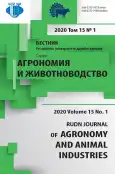Овсяный талган как источник антиоксидантов в функциональных продуктах питания
- Авторы: Сумина А.В.1, Полонский В.И.2,3, Шалдаева Т.М.4, Шулбаева М.Т.5
-
Учреждения:
- Хакасский государственный университет им. Н. Ф. Катанова
- Красноярский государственный аграрный университет
- Сибирский федеральный университет
- Центральный Сибирский ботанический сад СО РАН
- Кемеровский государственный университет
- Выпуск: Том 15, № 1 (2020)
- Страницы: 19-29
- Раздел: Растениеводство
- URL: https://journal-vniispk.ru/2312-797X/article/view/316880
- DOI: https://doi.org/10.22363/2312-797X-2020-15-1-19-29
- ID: 316880
Цитировать
Полный текст
Аннотация
Цель исследования состояла в изучении суммарного содержания антиоксидантов (ССА) в национальном хакасском продукте талган на основе зерна овса. Талган изготавливали по традиционному (обжаривание, измельчение) и инновационному (измельчение, обжаривание) способам. В данной серии опытов использовали три сорта овса: Аргумент и Тубинский, по типу зерновки относящиеся к пленчатым формам, Голец - к голозерным. Все образцы выращивались на территории Бейского госсортоучастка Республики Хакасия, которая характеризуется благоприятными климатическими условиями с позиций выращивания зерна с повышенным содержанием антиоксидантов. Для определения ССА в зерне использовали 2 растворителя: бидистиллированную воду и 70%-й этанол. Измерение ССА выполняли на приборе «Цвет Яуза-01-АА». В качестве образца сравнения использовали галловую кислоту. В овсяном талгане, изготовленном по традиционному способу из пленчатых образцов, суммарное содержание антиоксидантов имело более высокое значение, чем в исходном зерне до обработки (независимо от природы элюента), а в случае применения голозерного образца наблюдалась обратная тенденция. Более высокие показатели среди всех образцов были зарегистрированы при использовании в качестве элюента горячей бидистиллированной воды. Применение инновационного способа изготовления талгана показало, что суммарное содержание антиоксидантов у всех образцов имело более высокие значения в сравнении с традиционной методикой. С помощью трехфакторного анализа установлено, что значения ССА в овсяном талгане на две трети зависят от способа изготовления продукта, вклад природы растворителя и генотипа значительно меньше.
Ключевые слова
Об авторах
Алена Владимировна Сумина
Хакасский государственный университет им. Н. Ф. Катанова
Автор, ответственный за переписку.
Email: alenasumina@list.ru
кандидат сельскохозяйственных наук, доцент, доцент кафедры химии и геоэкологии
г. Абакан, Российская ФедерацияВадим Игоревич Полонский
Красноярский государственный аграрный университет; Сибирский федеральный университет
Email: vadim.polonskiy@mail.ru
доктор биологических наук, профессор кафедры ботаники и защиты растений
г. Красноярск, Российская ФедерацияТатьяна Михайловна Шалдаева
Центральный Сибирский ботанический сад СО РАН
Email: tanja.shaldaeva@yandex.ru
кандидат биологических наук
г. Новосибирск, Российская ФедерацияМаргарита Терентьевна Шулбаева
Кемеровский государственный университет
Email: sh-m-t@yandex.ru
кандидат технических наук, доцент кафедры технологического проектирования пищевых производств
г. Кемерово, Российская ФедерацияСписок литературы
- Moure A, Cruz JM, Franco D., Domı́nguez JM, Sineiro J, Domı́nguez H, et al. Natural antioxidants from residual. Food Chemistry. 2001; 72(2):145–171. doi: 10.1016/S0308–8146(00)00223–5doi.org/10.1016/ S0308–8146(00)00223–5
- Tufan AN, Çelik SE, Özyürek M, Güçlü K, Apak R. Direct measurement of total antioxidant capacity of cereals: QUENCHER-CUPRAC method. Talanta. 2013; 108(4):136–142. doi: 10.1016/j.talanta.2013.02.061.
- Adom KK, Liu RH. Antioxidant Activity of Grains. Journal of Agricultural and Food Chemistry. 2002; 50(21):6182–6187. doi: 10.1021/jf0205099
- Liu RH. Whole grain phytochemicals and health. Journal of Cereal Science. 2007; 46(3):207–219. doi: 10.1016/j.jcs.2007.06.010
- Neacsu M, McMonagle J, Fletcher RJ, Scobbie L, Duncan GJ, Cantlay L, et al. Bound phytophenols from ready-to-eat cereals: Comparison with other plant-based foods. Food Chemistry. 2013; 141(3):2880–2886. doi: 10.1016/j.foodchem.2013.05.023
- Ryan L, Thondre PS, Henry CJK. Oat-based breakfast cereals are a rich source of polyphenols and high in antioxidant potential. Journal of Food Composition and Analysis. 2011; 24(7):929–934. doi: 10.1016/j. jfca.2011.02.002
- Das AK, Singh V. Antioxidative free and bound phenolic constituents in pericarp, germ and endosperm of Indian dent (Zea mays var. indentata) and flint (Zea mays var. indurata) maize. Journal of Functional Foods. 2015; 13(2):363–374. doi: 10.1016/j.jff.2015.01.012
- Aprodu I, Banu I. Antioxidant properties of wheat mill streams. Journal of Cereal Science. 2012; 56(2):189–195. doi: 10.1016/j.jcs.2012.05.005
- Patel S. Cereal bran fortified-functional foods for obesity and diabetes management: Triumphs, hurdles and possibilities. Journal of Functional Foods. 2015; 14:255–269. doi: 10.1016/j.jff.2015.02.010
- Menga V, Fares C, Troccoli A, Cattivelli L, Baiano A. Effects of genotype, location and baking on the phenolic content and some antioxidant properties of cereal species. International Journal of Food Science and Technology. 2010; 45(1):7–16. doi: 10.1111/j.1365–2621.2009.02072.x
- Borodulin DM, Shulbaeva MT, Musina ON, Shepieva BM. Innovative technology of talgan producing as a component of functional food products, taking into account national traditions of nutrition. Food processing: techniques and technology. 2017; (3):15–22. (In Russ).
- Fedina PA, Yashin AY, Chernousova NI. Determination of antioxidants in plant products by amperometric method. Chemistry of plant raw material. 2010; (2):91–97. (In Russ).
- Polonsky VI, Sumina AV, Shaldaeva TM. The content of antioxidants in Siberian grain varieties of oats grown in various conditions. Bulletin of KSAU. 2018; (1):18–24. (In Russ).
- Akimova OI, Akimov DN. The use of statistical methods for processing of experimental data when performing student papers. Vestnik KhGU. 2016;(18):76–78. (In Russ).
Дополнительные файлы










